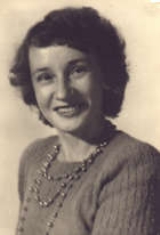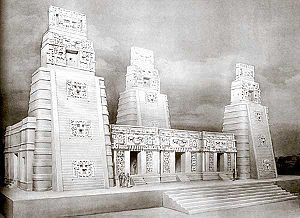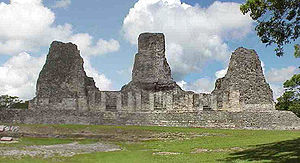
Tatiana Proskouriakoff
Encyclopedia
Tat’yana Avenirovna Proskuriakova ( – August 30, 1985) was an American
Mayanist
scholar and archaeologist who contributed significantly to the decipherment of Maya hieroglyphs
, the writing system
of the pre-Columbian
Maya civilization
of Mesoamerica
.
, Russian Empire
, to a chemist and his physician wife. The family travelled to the United States
in 1915, her father being asked by Tsar Nicholas II to oversee the production of munitions for World War I
. The Russian Revolution
forced the family to remain permanently. She was to visit Russia only once after that, to meet the Mayanist Yuri Knorozov.
She was devoted to a career in interpreting art, architecture, and hieroglyphic. While growing up, Tatiana could read fluently at the age of 3. She had a talent for drawing and received lessons in art and watercolor.
They lived for a while in Ohio
, and moved to the Philadelphia area before settling down in Lansdowne, Pennsylvania
. Tatiana did very well at school, was the editor of the school yearbook, and graduated valedictorian of her class.
She spent a year studying at the University of Pennsylvania
before graduating from the Pennsylvania State University
in 1930. Initially educated as an architect, she later went on to work for Linton Satterthwaite
and for the University of Pennsylvania Museum at the Maya site of Piedras Negras
in 1936–37. The Piedras Negras are found between Mexico and Guatemala. Traveling there was the start of her life's work as she found a passion for studying the ancient Maya. She made a reconstruction drawing of the Piedras Negras Acropolis on her return to Philadelphia. She was buried there in the F group; a plaque in her honor shows her tomb.

 While enrolled in graduate studies at the University of Pennsylvania, Proskouriakoff prepared archeological illustrations as a volunteer at the University Museum. Through her work with the Museum’s Assistant Curator of the American Section, Linton Satterthwaite, Proskouriakoff received an invitation in 1936 to join the Museum’s excavation work at the Mayan site of Piedras Negras.
While enrolled in graduate studies at the University of Pennsylvania, Proskouriakoff prepared archeological illustrations as a volunteer at the University Museum. Through her work with the Museum’s Assistant Curator of the American Section, Linton Satterthwaite, Proskouriakoff received an invitation in 1936 to join the Museum’s excavation work at the Mayan site of Piedras Negras.
Although Proskouriakoff never received a degree in the field of Maya studies, her dedication and ability for it led to her receiving positions at the Carnegie Institution in Washington D.C., then later at Harvard University. Her position at Carnegie was procured when Sylvanus Morley
saw the panoramic reconstruction on a visit to the Museum; he was impressed, and prevailed upon her to make more for the Carnegie Institution of Washington. Unable to get the institution to hire her, he raised funds to enable Proskouriakoff to travel to Copán
and Yucatán
, which she did in 1939. Returning after she completed the drawings, she was given the post of a research associate at the Institution in the early 1940s.
She soon became involved in Maya hieroglyphs and made significant contributions to the understanding of Mayan written language. For example, her 1942 scholarly analysis of the hieroglyphics at the Takalik Abaj ruins
in Guatemala
establish that the site was in part Maya
, settling a debate at that time. Her greatest contribution was considered the breakthrough for Maya hieroglyphic decipherment in the late 1950s and early 1960s. Utilizing the theories of Yuri Knorozov, she discovered that the writing on the monumental stela and other buildings was actually historical, dealing with the birth, accession, and death dates for the Maya rulers. Analyzing the pattern of dates and hieroglyphs, she was able to demonstrate a sequence of seven rulers who ruled over a span of two hundred years. Knowing the context of the inscriptions, Maya epigraphers were then able to decipher the hieroglyphs.
She became honorary curator, Maya art
, of the Peabody Museum
in 1958.
Tatiana Proskouriakoff died in Cambridge, Massachusetts
, on August 30, 1985. She was 76 years old.
United States
The United States of America is a federal constitutional republic comprising fifty states and a federal district...
Mayanist
Mayanist
A Mayanist is a scholar specialising in research and study of the Central American pre-Columbian Maya civilization. This discipline should not be confused with Mayanism, a collection of New Age beliefs about the ancient Maya....
scholar and archaeologist who contributed significantly to the decipherment of Maya hieroglyphs
Maya script
The Maya script, also known as Maya glyphs or Maya hieroglyphs, is the writing system of the pre-Columbian Maya civilization of Mesoamerica, presently the only Mesoamerican writing system that has been substantially deciphered...
, the writing system
Writing system
A writing system is a symbolic system used to represent elements or statements expressible in language.-General properties:Writing systems are distinguished from other possible symbolic communication systems in that the reader must usually understand something of the associated spoken language to...
of the pre-Columbian
Pre-Columbian
The pre-Columbian era incorporates all period subdivisions in the history and prehistory of the Americas before the appearance of significant European influences on the American continents, spanning the time of the original settlement in the Upper Paleolithic period to European colonization during...
Maya civilization
Maya civilization
The Maya is a Mesoamerican civilization, noted for the only known fully developed written language of the pre-Columbian Americas, as well as for its art, architecture, and mathematical and astronomical systems. Initially established during the Pre-Classic period The Maya is a Mesoamerican...
of Mesoamerica
Mesoamerica
Mesoamerica is a region and culture area in the Americas, extending approximately from central Mexico to Belize, Guatemala, El Salvador, Honduras, Nicaragua, and Costa Rica, within which a number of pre-Columbian societies flourished before the Spanish colonization of the Americas in the 15th and...
.
Early life
She was born in TomskTomsk
Tomsk is a city and the administrative center of Tomsk Oblast, Russia, located on the Tom River. One of the oldest towns in Siberia, Tomsk celebrated its 400th anniversary in 2004...
, Russian Empire
Russian Empire
The Russian Empire was a state that existed from 1721 until the Russian Revolution of 1917. It was the successor to the Tsardom of Russia and the predecessor of the Soviet Union...
, to a chemist and his physician wife. The family travelled to the United States
United States
The United States of America is a federal constitutional republic comprising fifty states and a federal district...
in 1915, her father being asked by Tsar Nicholas II to oversee the production of munitions for World War I
World War I
World War I , which was predominantly called the World War or the Great War from its occurrence until 1939, and the First World War or World War I thereafter, was a major war centred in Europe that began on 28 July 1914 and lasted until 11 November 1918...
. The Russian Revolution
Russian Revolution of 1917
The Russian Revolution is the collective term for a series of revolutions in Russia in 1917, which destroyed the Tsarist autocracy and led to the creation of the Soviet Union. The Tsar was deposed and replaced by a provisional government in the first revolution of February 1917...
forced the family to remain permanently. She was to visit Russia only once after that, to meet the Mayanist Yuri Knorozov.
She was devoted to a career in interpreting art, architecture, and hieroglyphic. While growing up, Tatiana could read fluently at the age of 3. She had a talent for drawing and received lessons in art and watercolor.
They lived for a while in Ohio
Ohio
Ohio is a Midwestern state in the United States. The 34th largest state by area in the U.S.,it is the 7th‑most populous with over 11.5 million residents, containing several major American cities and seven metropolitan areas with populations of 500,000 or more.The state's capital is Columbus...
, and moved to the Philadelphia area before settling down in Lansdowne, Pennsylvania
Lansdowne, Pennsylvania
Lansdowne is a borough in Delaware County, Pennsylvania, United States located southwest of downtown Philadelphia. It was named for the Marquess of Lansdowne. The borough grew quickly in the early part of the twentieth century when a railroad stop was established near the intersection of...
. Tatiana did very well at school, was the editor of the school yearbook, and graduated valedictorian of her class.
She spent a year studying at the University of Pennsylvania
University of Pennsylvania
The University of Pennsylvania is a private, Ivy League university located in Philadelphia, Pennsylvania, United States. Penn is the fourth-oldest institution of higher education in the United States,Penn is the fourth-oldest using the founding dates claimed by each institution...
before graduating from the Pennsylvania State University
Pennsylvania State University
The Pennsylvania State University, commonly referred to as Penn State or PSU, is a public research university with campuses and facilities throughout the state of Pennsylvania, United States. Founded in 1855, the university has a threefold mission of teaching, research, and public service...
in 1930. Initially educated as an architect, she later went on to work for Linton Satterthwaite
Linton Satterthwaite
Linton Sattherthwaite Jr. was a Maya archaeologist and epigrapher and is primarily associated with the University Museum at the University of Pennsylvania...
and for the University of Pennsylvania Museum at the Maya site of Piedras Negras
Piedras Negras, Guatemala
Piedras Negras is the modern name for a ruined city of the pre-Columbian Maya civilization located on the north bank of the Usumacinta River in the Petén department of Guatemala. The name Piedras Negras means "black stones" in Spanish...
in 1936–37. The Piedras Negras are found between Mexico and Guatemala. Traveling there was the start of her life's work as she found a passion for studying the ancient Maya. She made a reconstruction drawing of the Piedras Negras Acropolis on her return to Philadelphia. She was buried there in the F group; a plaque in her honor shows her tomb.
Reconstructive archaeology


Although Proskouriakoff never received a degree in the field of Maya studies, her dedication and ability for it led to her receiving positions at the Carnegie Institution in Washington D.C., then later at Harvard University. Her position at Carnegie was procured when Sylvanus Morley
Sylvanus Morley
Sylvanus Griswold Morley was an American archaeologist, epigrapher, and Mayanist scholar who made significant contributions toward the study of the pre-Columbian Maya civilization in the early twentieth century....
saw the panoramic reconstruction on a visit to the Museum; he was impressed, and prevailed upon her to make more for the Carnegie Institution of Washington. Unable to get the institution to hire her, he raised funds to enable Proskouriakoff to travel to Copán
Copán
Copán is an archaeological site of the Maya civilization located in the Copán Department of western Honduras, not far from the border with Guatemala. It was the capital city of a major Classic period kingdom from the 5th to 9th centuries AD...
and Yucatán
Yucatán
Yucatán officially Estado Libre y Soberano de Yucatán is one of the 31 states which, with the Federal District, comprise the 32 Federal Entities of Mexico. It is divided in 106 municipalities and its capital city is Mérida....
, which she did in 1939. Returning after she completed the drawings, she was given the post of a research associate at the Institution in the early 1940s.
She soon became involved in Maya hieroglyphs and made significant contributions to the understanding of Mayan written language. For example, her 1942 scholarly analysis of the hieroglyphics at the Takalik Abaj ruins
Takalik Abaj
Tak'alik Ab'aj is a pre-Columbian archaeological site in Guatemala; it was formerly known as Abaj Takalik; its ancient name may have been Kooja. It is one of several Mesoamerican sites with both Olmec and Maya features...
in Guatemala
Guatemala
Guatemala is a country in Central America bordered by Mexico to the north and west, the Pacific Ocean to the southwest, Belize to the northeast, the Caribbean to the east, and Honduras and El Salvador to the southeast...
establish that the site was in part Maya
Maya civilization
The Maya is a Mesoamerican civilization, noted for the only known fully developed written language of the pre-Columbian Americas, as well as for its art, architecture, and mathematical and astronomical systems. Initially established during the Pre-Classic period The Maya is a Mesoamerican...
, settling a debate at that time. Her greatest contribution was considered the breakthrough for Maya hieroglyphic decipherment in the late 1950s and early 1960s. Utilizing the theories of Yuri Knorozov, she discovered that the writing on the monumental stela and other buildings was actually historical, dealing with the birth, accession, and death dates for the Maya rulers. Analyzing the pattern of dates and hieroglyphs, she was able to demonstrate a sequence of seven rulers who ruled over a span of two hundred years. Knowing the context of the inscriptions, Maya epigraphers were then able to decipher the hieroglyphs.
She became honorary curator, Maya art
Maya art
Maya art, here taken to mean the visual arts, is the artistic style typical of the Maya civilization, that took shape in the course the Preclassic period , and grew greater during the Classic period Maya art, here taken to mean the visual arts, is the artistic style typical of the Maya...
, of the Peabody Museum
Peabody Museum of Archaeology and Ethnology
The Peabody Museum of Archaeology and Ethnology is a museum affiliated with Harvard University in Cambridge, Massachusetts, USA.Founded in 1866, the Peabody Museum is one of the oldest and largest museums focusing on anthropological material, and is particularly strong in New World ethnography and...
in 1958.
Tatiana Proskouriakoff died in Cambridge, Massachusetts
Cambridge, Massachusetts
Cambridge is a city in Middlesex County, Massachusetts, United States, in the Greater Boston area. It was named in honor of the University of Cambridge in England, an important center of the Puritan theology embraced by the town's founders. Cambridge is home to two of the world's most prominent...
, on August 30, 1985. She was 76 years old.
Awards and recognition
- Alfred V. Kidder Medal for eminence in American archaeology, 1962
- Woman of the Year by Penn State, 1971
- Order of the QuetzalOrder of the QuetzalThe Order of the Quetzal is Guatemala’s highest honor. Established in 1973, it is bestowed by the Government of Guatemala. The award acknowledges officials of nations, organizations and other entities whose artistic, civic, humanitarian, or scientific works merit special recognition....
, Guatemala's highest honor, 1984 - Honorary Doctorate of Laws from Tulane UniversityTulane UniversityTulane University is a private, nonsectarian research university located in New Orleans, Louisiana, United States...
, 1977 - Elected to membership in the American Philosophical Society, 1983
Published works
Proskouriakoff's publications include:- An Inscription on a Jade Probably Carved at Piedras Negras Notes on Middle American Archaeology and Ethnology II, 1944
- An Album of Maya Architecture, 1946
- Middle American Art, 1950
- A Study of Classic Maya Sculpture Carnegie Institute of Washington Publication No. 593, 1950
- Varieties of Classic Central Veracruz Sculpture American Anthropology and History LVIII, 1954
- Historical Implications of a Pattern of Dates at Piedras Negras, Guatemala American Antiquity XXV, 1960
- Portraits of Women in Maya Art, 1961
- Lords of the Maya Realm Expedition Magazine IV(1) 1961
- Mayapán, Yucatán, Mexico (with H E D Pollock, A L Smith and R L Roys) Carnegie Institute of Washington Publication No. 619, 1962
- Historical Data in the Inscriptions of Yaxchilan, Part 1 Estudios de Cultura Maya III, 1963
- Historical Data in the Inscriptions of Yaxchilan, Part 2 Estudios de Cultura Maya IV, 1964
- Olmec and Maya Art: Problems of Their Stylistic Relation Dumbarton Oaks Conference on the Olmec, 1968
- Classic Art of Central Veracruz Handbook of Middle American Indians Vol XI, 1971
- Jades from the Cenote of Sacrifice
- Maya History, 1993 (ISBN 978-0-292-76600-6)
- Graphic designs on Mesoamerican pottery
- Maya calendar round dates such as 9 Ahau 17 Mol
- The Maya : An Introduction (with L S Spotnitz, J A Sabloff and G R Willey)

